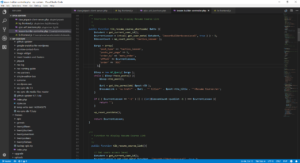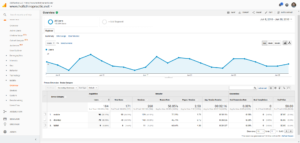Components of a Website Design & Development Project
Everyone knows what a website is, but not necessarily what pieces are required to create a working website. Below, you’ll find a brief reference to the different components of a website design & development project that will apply to ANY website.
Planning
 Ok, while not really an actual component of a website, planning out your website project is likely the most critical step, and often overlooked. The bulk of planning should happen before the design process even begins, but often you’ll need to stay flexible and re-adjust your plan as the site grows, or you gain new intelligence on how your audience uses it.
Ok, while not really an actual component of a website, planning out your website project is likely the most critical step, and often overlooked. The bulk of planning should happen before the design process even begins, but often you’ll need to stay flexible and re-adjust your plan as the site grows, or you gain new intelligence on how your audience uses it.
I remember a meeting with a client, where we discussed using an “Under Construction… Coming Soon” placeholder for a new feature. Our clients response was profound:
“A website should always be under construction and growing, there is no need to tell our visitors”.
He was right, your website will always be changing and growing, so stay flexible and be willing to re-visit your initial plans often.
Your website plan should cover topics such as target audience, content organization, site navigation, monetizing, and future growth and scaling. This is just a start, and we could dedicate an entire post to this topic. While not exhaustive, check out Creative Bloq’s article, 5 steps to planning a website, to get started.
Designing, or updating a website without a well thought-out plan is a recipe for a clunky, ugly, messy, and EXPENSIVE website.
Branding & Design
 The branding and design component involves creating a look and feel that matches your business’ voice and tone. The design should reflect and promote your business just as if you were personally providing services or information to your audience instead of your website.
The branding and design component involves creating a look and feel that matches your business’ voice and tone. The design should reflect and promote your business just as if you were personally providing services or information to your audience instead of your website.
The branding and design phase will include research about your audience and how your business relates to them, how user-interactions work, and general usability. Remember the planning we did as part of the first component? You’ve just saved yourself some time in the branding & design phase… hand over your Audience Research and Website Plan to your designer, and enjoy seeing them nail your concept, bringing it all to life.
Development
 Development generally starts after the Branding & Design phase is complete. Sometimes development can happen in parallel to design, as there are usually administrative back-ends, and frameworks that can be set up without prior knowledge of the client-facing design.
Development generally starts after the Branding & Design phase is complete. Sometimes development can happen in parallel to design, as there are usually administrative back-ends, and frameworks that can be set up without prior knowledge of the client-facing design.
Web Development is where you get to turn 2 dimensional designs into a usable experience. Development can be as simple as implementing your designs and concepts in pre-built website packages like Squarespace & Weebly, or more complexly by custom coding the logic and functionality of your designs.
Hosting
Website Hosting is the physical space that your website resides on. This physical space is usually called a server, and is very similar to a desktop computer that is designed to only run websites. These servers are connected to the internet allowing your site to be visible to the public. You could think of it as the property that your home resides on. It would be impossible to build a home, without the real-estate to put the home on. Hosting for most small and medium sized businesses is rented on a monthly or yearly basis.
The type of hosting you’ll need depends on factors such as performance needs, expected user-traffic levels, support provided, and available features. Most small businesses start out with ‘Shared Hosting’, which means there are multiple website owners storing their websites on the same server or servers. As your website demands increase, larger businesses will move to ‘Virtual Private Servers’, ‘Dedicated Servers’, or other technologies such as Amazon’s AWS.
Domain
Every website needs a Domain, which is the address to your website. To revisit the home example from above, if you wanted a friend to find your home, you would give them the address. A website address is what you type into the web browser to navigate to a website. An example of the address to our website is: www.360Tactics.net. Domains are usually registered, or rented by the year, with no limit on how many years you can register it for.
After you have registered a domain name, you can “point” the domain to the server where your website is hosted, so that users can find your website easily.
Analytics
 Once your website is launched, analytics is the data collected from your visitors use of your website that helps provide insights on what works, what doesn’t, and helps direct plans for the future growth of your website. The data collected generally is not user-identifiable, but includes information such as how long your users spend on the site, which pages they have looked at, how they arrived at your site, their general location, and much much more.
Once your website is launched, analytics is the data collected from your visitors use of your website that helps provide insights on what works, what doesn’t, and helps direct plans for the future growth of your website. The data collected generally is not user-identifiable, but includes information such as how long your users spend on the site, which pages they have looked at, how they arrived at your site, their general location, and much much more.
Google Analytics is one of the most used analytics software today. It’s important to get this component working on your site right away as you can’t collect data retro-actively.
SEO
Reaching the top search results in search engines like Google, Yahoo, and others is what SEO, or Search Engine Optimization is all about. We like to think of SEO as an ongoing battle against your competitors for the top marketing spots on the web.
Good SEO begins during the planning and development phases, and continues… well, forever. SEO is affected by MANY things, including the content of the website, and how the site is structured and coded.
Search engines analyze your website to try and determine what it’s all about. It will pick up on the main keywords of each page, and then assign a ranking based on how useful or relevant your site is with regards to these keywords. If you get a Google Rank of #3, and your competitor’s website gets a Google Rank of #5, your site was determined to be more useful than your competitors site and earned a place on the search results 2 places above your competitors listing.
Search Engines also consider things such as site-speed, security, longevity, and more in determining if your website is going to be applicable to the searcher. If all checks out, it will display a link to your site in it’s results… hopefully higher than your competitors!
Maintenance/Updates/Security
Website maintenance and updates are a critical component of a website design & development project, and must be planned for. Even if you don’t update the design, or features of your website, the technology it is based on is constantly changing in order to deal with the ever-changing landscape of security, efficiency, and standardization.
Each website may be built with one or more 3rd-party platforms or frameworks that are constantly being upgraded by their developers. The web server used for hosting the website should also be regularly upgraded to the latest tech in order to provide the fastest service available, and thwart the ever-increasing sophistication of hackers.
The complexity of the website will generally determine how much maintenance will be needed. Smaller sites may only need a few hours per year of updates and maintenance, while large-scale websites (think ESPN, Amazon, Nike) require a team of developers working year-round.
Conclusion
Hopefully, you now have a little better understanding of what is required for a website to exist. Go ahead and test your new knowledge by explaining to your grandmother what you’ve learned. You know you are an expert when Grandma stops looking at you like you are speaking gibberish. If you are still confused, feel free to drop us a line or leave a comment below!

